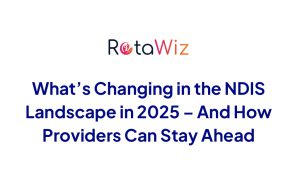6 June, 2025
The NDIS Landscape Is Evolving — Here’s What Providers Should Be Watching
NDIS latest news
6 min read
As the NDIS continues to grow and mature, the expectations placed on providers are shifting. It’s no longer just about delivering support—it’s about doing so with agility, precision, and a deep understanding of changing participant needs.
From participant growth to shifts in plan budgets and service utilisation, the data paints a clear picture: providers who stay informed and flexible are in a stronger position to deliver quality outcomes while managing operations sustainably.
The latest national figures offer key insights into where the sector is heading:

Understanding these trends is essential for making informed decisions—whether you’re expanding into a new region, reassessing service models, or adjusting team capacity. In the sections below, we unpack the data-backed changes shaping provider operations in 2025 and beyond.
A Maturing Scheme with New Expectations
The early years of the NDIS were largely about onboarding—getting participants into the scheme and building up provider capacity. But today’s landscape is more complex. There are more participants, more data, and more demand for outcomes that align with participant goals and lived experiences.
This maturity brings both opportunity and responsibility. Participants are more aware of their choices, and support plans are becoming more tailored over time. This means providers must regularly reassess not j ust what they offer, but how and where they offer it.
Whether you’re delivering core supports, SIL services, or exploring opportunities in SDA, understanding participant needs and emerging trends is now a critical part of operational planning.
Key Trends Providers Should Know
1. Participant Plans Are Becoming More Fluid
Plan reassessments are becoming more common, and in many cases, budgets are increasing significantly. This is especially true for participants whose needs were previously underestimated or whose circumstances have changed rapidly.
For providers, this reinforces the importance of ongoing engagement and documentation. Regular check-ins, proactive reporting, and clear communication can help participants prepare for reassessments and make a case for the services they truly need.
More fluid budgets also mean providers must be ready to scale support up or down. This might involve changes in staffing, rostering, or coordination with allied health professionals. Flexibility isn’t just helpful—it’s increasingly necessary.
2. Plan Utilisation Rates Highlight Gaps in Access or Engagement
Utilisation rates differ significantly between service types. Supported Independent Living (SIL) participants often have high utilisation rates, thanks to structured support environments. However, non-SIL participants frequently leave a portion of their plan funding unspent.
This underutilisation isn’t always due to lack of need—it can stem from challenges accessing services, unclear support plans, or low participant confidence in navigating the system.
Providers who can close these gaps—by offering easy-to-understand onboarding, regular communication, and participant empowerment—will be in a better position to support consistent plan usage and build longer-term relationships.
3. SDA Demand Is Rising, and Unevenly Distributed
The need for Specialist Disability Accommodation (SDA) is increasing, but the demand isn’t evenly spread. Some areas are seeing far higher levels of unmet SDA need than others.
While housing supply remains a challenge across the board, these pockets of higher demand offer a clear signal to providers considering where to focus future investment or partnerships.
SDA is a highly regulated space that requires careful planning, from participant eligibility to building standards. But for providers who understand these nuances, there’s room to meet a growing and important need.
4. Regional Differences Matter More Than Ever
Although the NDIS is a national program, funding levels, service costs, and participant needs vary significantly across states and territories. In more remote or underserved areas, per-participant funding may be higher to reflect the additional resources needed to deliver care.
For providers, this means adopting a regional lens when reviewing performance and planning growth. What works in metropolitan Melbourne may need to be reconfigured for regional Queensland or remote areas of the Northern Territory.
Understanding these regional differences helps providers make better decisions about pricing, staffing, and even the types of services offered. It’s not about one-size-fits-all—it’s about thoughtful, localised delivery.
Strategic Considerations for Providers
So what does all this mean on a practical level? Here are a few strategic questions every provider should be asking as we move further into 2025:
- Are our current services aligned with the evolving needs of participants?
- Are we seeing underutilisation in specific service areas—and if so, why?
- Do we have visibility into local SDA or SIL demand in the regions we serve?
- Are we prepared to scale services in response to reassessments or budget increases?
- Is our operational model flexible enough to support both complex and low-intensity supports?
Answering these questions isn’t always simple. It may involve changes in internal systems, new workforce strategies, or better integration between departments. But being proactive now means being more stable and responsive later.
From Insight to Action
Staying informed about sector-wide trends is the first step. The next is putting that insight into action in a way that strengthens your organisation and supports participant outcomes.
This might look like:
- Adjusting your rostering system to better match demand patterns.
- Creating onboarding resources to help participants understand and use their plans effectively.
- Building collaborative relationships with other local providers to address SDA or therapy gaps.
- Implementing team dashboards that track plan utilisation and reassessment outcomes.
- Using data to inform future service planning or community engagement.
This is where provider tools like RotaWiz can play a key role—by helping teams manage staff allocation, service delivery timelines, and participant schedules in one streamlined environment. With built-in flexibility and visibility, tools like these can support better decisions, faster response times, and more coordinated participant care.
Each of these moves supports a stronger, more participant-focused organisation. And in a system where funding and trust are linked, that matters.
Supporting Participants in a Time of Change
Amid all the structural shifts, one constant remains: the purpose of the NDIS is to support people with disability to live the life they choose.
This means that even as data grows more detailed and service models become more sophisticated, the core goal is still connection, support, and dignity. Providers who stay rooted in that purpose—while also adapting to policy, funding, and regional shifts—are the ones best positioned to serve effectively in 2025 and beyond.
Navigating Change With Clarity
As the sector evolves, one thing is certain—providers need to stay responsive. Whether it’s understanding plan reassessment trends, addressing underutilisation, or aligning services with demand in SDA or SIL, acting on reliable insights makes a real difference.
These trends aren’t just numbers—they reflect the lived experiences of participants and the operational decisions providers make every day. Taking the time to reflect on where demand is shifting and where services can be strengthened helps teams deliver with confidence and clarity.
By staying informed and working adaptively, providers can deliver services that not only meet today’s needs, but also grow sustainably into tomorrow.


